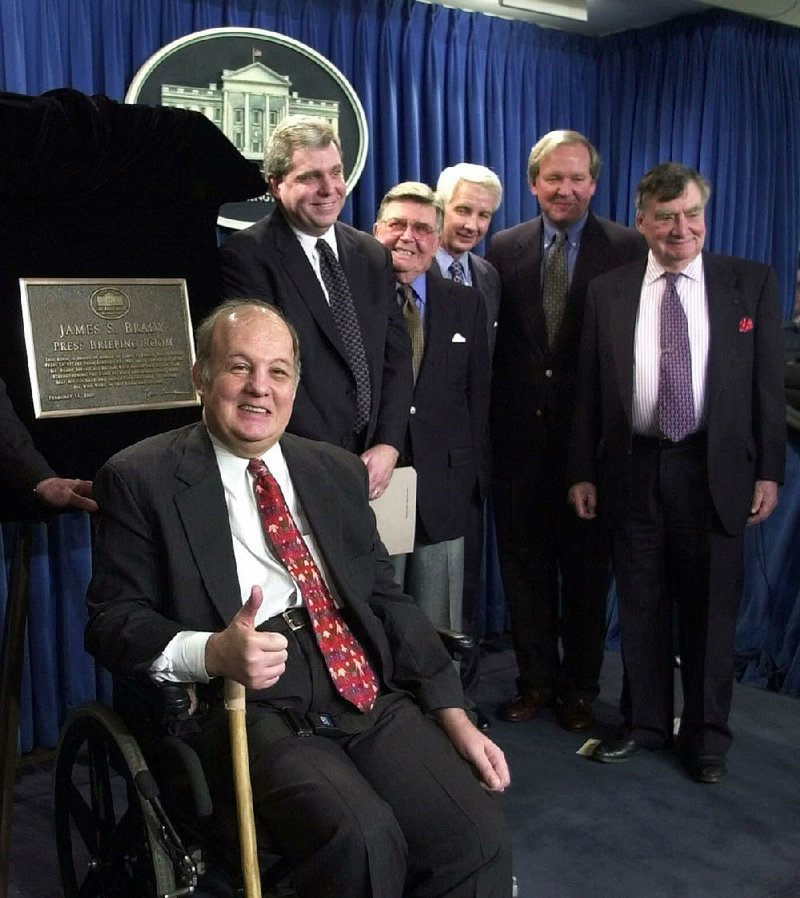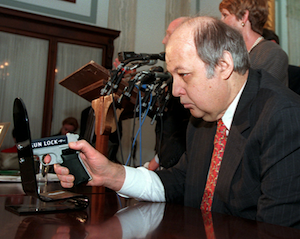WASHINGTON — James Brady, the affable, witty press secretary who survived a devastating head wound in the 1981 assassination attempt on President Ronald Reagan and undertook a personal crusade for gun control, died Monday. He was 73.
“We are heartbroken to share the news that our beloved Jim ‘Bear’ Brady has passed away after a series of health issues,” Brady’s family said in a statement. “His wife, Sarah, son, Scott, and daughter, Missy, are so thankful to have had the opportunity to say their farewells.”
Brady, who spent much of the rest of his life in a wheelchair, died at a retirement community in Alexandria, Va., where he lived with his wife.
He suffered a bullet wound in his head in the assassination attempt outside the Washington Hilton Hotel on March 30, 1981.
Although he returned to the White House only briefly, he was allowed to keep the title of presidential press secretary and his White House salary until Reagan left office in January 1989.
Former first lady Nancy Reagan said she was “deeply saddened to learn of Jim Brady’s passing today. Thinking of him brings back so many memories — happy and sad — of a time in all of our lives when we learned what it means to ‘play the hand we’re dealt.’”
“I still remember vividly that day in March 1981, when Sarah and I sat together in a tiny room near the emergency room at George Washington University Hospital, trying to comfort each other while we both were gripped with unspeakable fear,” Nancy Reagan said. “The bond we established then was unlike any other.”
A federal law requiring a background check on handgun buyers bears his name, as does the White House press briefing room.
Dan Gross, president of the Brady Campaign to Prevent Gun Violence, said in a statement that because of Brady’s work on gun control “an estimated 2 million gun sales to criminals, domestic abusers and other dangerous people have been blocked. As a result, countless lives have been saved. In fact, there are few Americans in history who are as directly responsible for saving as many lives as Jim.”
Of the four people struck by gunfire in the assassination attempt by John Hinckley Jr. — later found to be insane — Brady was the most seriously wounded.
A news clip of the shooting, replayed often on television, showed Brady sprawled on the ground as Secret Service agents hustled the wounded president into his limousine.
Reagan was shot in one lung while a policeman and a Secret Service agent suffered lesser wounds.
Brady never regained full health. The shooting caused brain damage, partial paralysis, short-term memory impairment, slurred speech and constant pain.
The TV replays of the shooting did take a toll on Brady, however.
He said years later that he relived the moment each time he saw it: “I want to take every bit of [that] film … and put them in a cement incinerator, slosh them with gasoline and throw a lighted cigarette in.”
He endured a series of brain operations in the years after the shooting.
Brady was a strong Republican from an early age — as a boy of 12 in Centralia, Ill., where he was born Aug. 29, 1940, he distributed election literature for Dwight D. Eisenhower.
In a long string of political jobs, Brady worked for some well-known bosses: Sen. Everett Dirksen of Illinois; Sen. William Roth Jr. of Delaware; and John Connally, the former Texas governor who was running for president in 1979. When Connally dropped out, Brady joined Reagan’s campaign as director of public affairs and research. There, his irrepressible wit made him popular with the press, but not necessarily with the Reaganites.
He once ran through the Reagan campaign plane shouting “Killer trees! Killer trees!” as the aircraft flew over a forest fire. It was a jab at his own candidate’s claim in a speech that trees cause as much pollution as cars.
Brady remained as transition spokesman after Reagan’s election.
But Reagan’s advisers appeared hesitant to give him the White House job. Nancy Reagan was said to feel the job required someone younger and better-looking than the 40-year-old, moon-faced, balding Brady.
“I come before you today not as just another pretty face, but out of sheer talent,” Brady told reporters. A week later, he got the job.
Sarah Brady became involved in gun control efforts in 1985, and later chaired Handgun Control Inc., but Brady took a few more years to join her, and Reagan did not endorse their efforts until 10 years after he was shot. Reagan’s surprise endorsement — he was a longtime National Rifle Association member and opponent of gun control laws — began to turn the tide in Congress.
The Brady law — formally known as the Brady Handgun Violence Prevention Act — required a five-day wait and background check before a handgun could be sold.
In November 1993, as President Bill Clinton signed the bill into law, Brady said: “Every once in a while you need to wake up and smell the propane. I needed to be hit in the head before I started hitting the bricks.”


